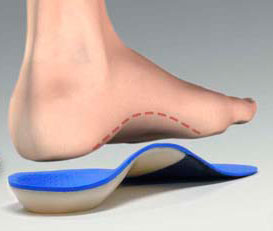 History and presenting symptoms:
History and presenting symptoms:
The patient is a 16-year-old athlete who plays football and baseball. He reports recurrent pain in his left ankle over the past year, especially after lengthy running practices. Occasionally, the ankle will swell, which he treats with an ice pack and over-the-counter anti-inflammatory drugs. He recalls no specific injury and has no significant disability, but is concerned for his future sports performance. Parental advice prompted him to seek chiropractic care.
Exam findings:
Vitals: The patient weighs 180 lbs, which, at 5’10’’, results in a body mass index (BMI) of 26—at his age, he is considered overweight. His appearance, however, confirms that excess weight is due to muscular development, not excess fat mass. He doesn’t smoke, and his blood pressure and pulse rate are well within normal range.
Posture and gait: Standing postural evaluation finds generally good alignment, with intact spinal curves, and no lateral listing of pelvis or spine. He demonstrates a mild bilateral knee valgus (more prominent on left), with bilateral pes planus and calcaneal eversion. These findings cause medial bowing of the Achilles tendons when standing, especially on the left. A toeing-out tendency (foot flare) is seen during gait screening; this is also somewhat more prominent on left.
Chiropractic evaluation: Motion palpation identifies a limitation in left sacroiliac motion, with moderate tenderness and loss of end range mobility. Several compensatory subluxations are identified throughout the thoracolumbar region. Orthopedic and neurological testing is negative.
Primary complaint: Left ankle examination reveals slight swelling of entire Achilles tendon, which is moderately tender to palpation. All left ankle ranges of motion are full and pain-free, except dorsiflexion, which is slightly limited by tightness, not pain. Manual muscle testing finds slight weakness in plantar flexion when compared to right side.
Imaging:
No X-rays or other forms of musculoskeletal imaging were requested.
Clinical impression:
Chronic, recurrent Achilles tendinosis secondary to lower extremity biomechanical stress. This is accompanied by sacroiliac joint motion restriction and compensatory thoracolumbar subluxations.
Treatment
Adjustment: Specific, corrective adjustments for the SI joints and thoracolumbar region were provided, as needed. Manipulation of the left talus during traction was performed to increase the range of ankle dorsiflexion motion.
Stabilization: Custom-made stabilizing orthotics were provided to support the arches, decrease calcaneal eversion, and reduce the asymmetrical biomechanical forces being transmitted to the spine and pelvis.
Rehabilitation: Initially, was taught to perform daily self-mobilization to increase left ankle dorsiflexion motion, along with towel-scrunching exercises. After two weeks, daily strengthening of plantar flexion was introduced, using elastic exercise tubing.
Response to care:
The spinal and pelvic adjustments were well-tolerated, and this young, in-shape athlete required few re-adjustments. His compliance with the stabilization and exercise recommendations was excellent, since he was motivated to improve his performance and prevent potential sports injuries. He adapted to and wore the orthotics without difficulty. He filled out and brought in his exercise log at every visit, which provided an opportunity to support his home-based efforts.
Within four weeks of receiving his orthotics, the patient was able to complete several long running practices without symptoms or swelling in the ankle. He described a noticeable improvement overall in his athletic performance. He was released from acute care to a self-directed maintenance program after a total of 12 visits over 2 months.
Discussion:
Using pediatric BMI calculations, this patient was classified as overweight. This and his high activity level are likely to be significant factors in his ankle problem. However, it is important to recognize that, in the case of athletes, overweight may be due to greater than usual amounts of lean body mass (muscle and bone), not fatty deposits. This was readily apparent during examination.
While the traditional term for this condition is “Achilles tendinitis,” the more accurate and contemporary description is “tendinosis.” As was apparent in this case, the problem is usually not an acute inflammatory event, but rather a long-standing biomechanical irritation that needs to have the underlying problem correctly addressed.
This case demonstrates that young athletes are superior patients. Most have a great healing potential and are willingly to follow self-care recommendations—particularly when they include the use of orthotics for stabilization, specific exercises for rehabilitation, and a rapid return to full sports function.
Dr. John J. Danchik is the seventh inductee to the American Chiropractic Association Sports Hall of Fame. He is the current chairperson of the United States Olympic Committee’s Chiropractic Selection Program. He lectures extensively in the United States and abroad on current trends in sports chiropractic and rehabilitation. Dr. Danchik is an associate editor of the Journal of the Neuromusculoskeletal System. He has been in private practice in Massachusetts for 29 years. He can be reached by e-mail at [email protected].
